Investigation into the Force of a Bullet
| ✅ Paper Type: Free Essay | ✅ Subject: Physics |
| ✅ Wordcount: 2687 words | ✅ Published: 11 Sep 2017 |
The Force of a Bullet
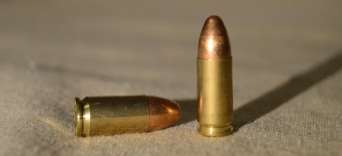


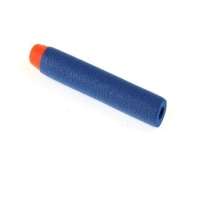

Abstract:
The aim of the experiment was to uncover whether or not, if when a person is shot in a movie and falls backwards is realistic. As the experiment was to see how far back a person goes when shot, the following hypothesis was made: if the momentum of a bullet out of a nerf gun is passed on to a toy soldier, then it will travel backwards because of the Momentum Conservation Principle. The hypothesis will be tested by using a nerf gun and bullet that will be shot at a toy soldier from various distances. Through the experimental data recorded, the hypothesis was found to be supported, however a new hypothesis could be developed to better suit this experiment.
Introduction:
21st century movies show dramatic improvements in the special effects that are used to make a better movie. Over time, shooting scenes have been the main point decider in movies in whether or not it seemed realistic or over exaggerated. Although Computer-Generated-Imagery (CGI) helps to make these scenes better, how reliable is the recoil of a person falling back from taking a shot in the chest, shoulder or even the head.

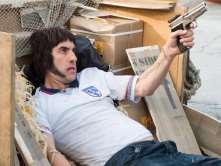 The realism of shooting in movies will be explored through investigating and experimenting to find out how realistic someone being shot and falling backwards is. The movie that will be used as the reference or comparison for this experiment is The Brothers Grimsby released in 2016 as an action cross adventure genre. The key scene that will be used from the movie is when Nobby, played by Sacha Baron Cohen, shoots two enemies using a 9mm gun as shown in the photo. This movie is used as the comparison due to the shooting scene looking realistic, in that when the two enemies are shot, they only fall backwards and don’t jump back five meters, giving the appearance of a realistic shot or kill. For the experiment, a nerf gun was used as the replica gun for this experiment.
The realism of shooting in movies will be explored through investigating and experimenting to find out how realistic someone being shot and falling backwards is. The movie that will be used as the reference or comparison for this experiment is The Brothers Grimsby released in 2016 as an action cross adventure genre. The key scene that will be used from the movie is when Nobby, played by Sacha Baron Cohen, shoots two enemies using a 9mm gun as shown in the photo. This movie is used as the comparison due to the shooting scene looking realistic, in that when the two enemies are shot, they only fall backwards and don’t jump back five meters, giving the appearance of a realistic shot or kill. For the experiment, a nerf gun was used as the replica gun for this experiment.
 The areas that will be explored in the experiment include Newton’s Third Law, which is defined as “For every action, there is an equal and opposite reaction” (Physicsclassroom.com, 2017). Newton’s Third Law affects the experiment in that when the bullet is shot from the nerf gun, the energy behind the bullet is equal to that of when it hits the object and pushes it back while the bullet deflects in any given direction.
The areas that will be explored in the experiment include Newton’s Third Law, which is defined as “For every action, there is an equal and opposite reaction” (Physicsclassroom.com, 2017). Newton’s Third Law affects the experiment in that when the bullet is shot from the nerf gun, the energy behind the bullet is equal to that of when it hits the object and pushes it back while the bullet deflects in any given direction.
Newton’s Third Law relates to the Momentum Conservation Principle. The principle is a collision between object 1 and object 2 in an isolated system. The total momentum of the two objects before the collision is equal to the amount of momentum after the collision (Physicsclassroom.com, 2017).
 The expression of the above text can be shown through the equation of, F1 = -F2. It shows that the magnitude is the same but in opposite directions.
The expression of the above text can be shown through the equation of, F1 = -F2. It shows that the magnitude is the same but in opposite directions.
The impulse in an object is equal to the change in momentum of that object (the impulse momentum change theorem). This means that the object contains positive and equal impulses. As an equation, this is expressed as:-
p1x∆V1=p2x ∆V2
p= momentum
∆V= change in velocity
Theoretical Calculations:
The scale that is used is 1:32 and came from the size of the object in which it represents a six and a half foot tall person.
Nerf gun bullet speed is 44.6 ft/s or 13.6 m/s meaning when scaled to see if the bullet is roughly the same speed of a 9mm bullet (Stoked About Science, 2017). The results came from an external experiment where the average firing speed was found.
Scale used is 1:32, therefore
32×44.6 = 1427.2 ft/s
32×13.6 = 435.2 m/s
The muzzle velocity of a 9mm bullet is 1246.7 ft/s or 380 m/s. The nerf gun when scaled is around the same speed of a 9mm, therefore it allows the experiment to be a realistic scale replica of the movies shooting scene.
Momentum of the nerf bullet where mass of bullet equals 0.001kg.
Momentum= mass x velocity
p= m x v
p= 0.001 x 13.6
p= 0.0136 kg/ms-1
m= mass of nerf bullet (1 gram)
v= speed of nerf bullet in (13.6 ms-1)
Momentum of the bullet equals 0.0136 kilograms-metre per second.
Using the momentum change theorem to find how far back the soldier went.
P= momentum P1=0.0136 P2=Unknown
∆v= change in velocity ∆v1=13.6 ∆v2=0.036

The equation is rearranged to find m2



Therefore the momentum of the toy soldier is equal to change in momentum of p1-p2.
Change in momentum 







To find the length of how far back the toy soldier went, the acceleration formula is used.




a = acceleration (ms2) 13.60 = 13.6-2.68×10-3
vf = the final velocity (m/s)
vi = the initial velocity (m/s)
t = the time in which the change occurs (s)
By finding the time, we can now calculate the distance by using the formula



The theoretical length of the distance of how far back the toy soldier should go is 0.49 meters.
Hypothesis:
By using the background research that has been collected, the following hypothesis for the experiment was formed.
If the momentum of a bullet out of a nerf gun is passed on to a toy soldier, then it will travel backwards because of the Momentum Conservation Principle.
Material List:
|
Nerf Gun |
The nerf gun was used as the comparison weapon to the 9mm gun used in the movie as it had similar speeds when scaled. |
|
Toy Soldier |
The toy soldier was the scaled replica of a human which was also the item that was shot at. |
|
Tape measure |
A tape measure was used to calculate the distance from where the shooter would be and to measure the length of how far back the toy soldier went when shot. |
|
30cm ruler |
A ruler was used to keep the toy soldier parallel to the spot where they were going to be shot from. |
|
Enclosed Dome measuring scale |
The scale was used to measure the mass of the soldier to help with calculations for the theoretical data. |


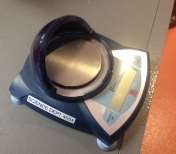
Method:
As the materials required could be sourced from home, there wasn’t any needed to be ordered at school. Finding a suitable place that wouldn’t be affected was the first priority as wind could easily blow the bullets around and have made the experiment harder to do. The classroom next to the physics room wasn’t in use and due to it having enough room to shoot; it was the perfect area to conduct the experiment. Some desk and chairs needed to be moved to allow a wide and long enough section where the tape measure could be laid out. A 30cm ruler was used as a reference point and laid across the two metre mark on the measuring tape.
The toy soldiers were placed just behind the ruler so they were parallel to the two metre mark on the tape measure. The shooter held the nerf gun at the four metre mark (two meters away from the targets) and shot the soldiers five times. Before every shot was taken, the shooter made sure that the front of the gun wasn’t past the four metre mark on the barrel so then the results would be as consistent as they could be. The range of where the shooter was changed at the end of the five shots by one metre (three metres away from the target) to see if there would be a change in the distance of how far back the toy soldier went. Five shots (that hit the targets) were fired again and the results recorded into a table. The distance was changed for the final length to be four metres away from the toy soldiers with five shots that hit the toy soldiers to be recorded. The results that were recorded took the data of the travel of the toy soldier from where it had been placed.
The dependent variable for the experiment is the change in distances of how far back the bullet was shot from. The independent variable of the test was the speed of the bullet as it didn’t change (the same gun was used). The controlled variable of the test was the object being hit and the room that the experiment was conducted in.
A layout of the experiment is shown below.

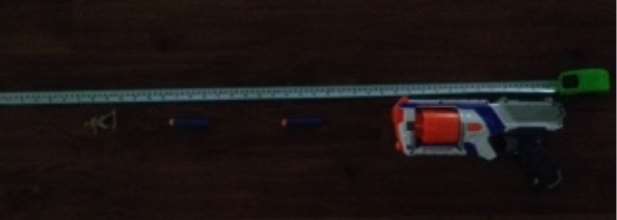
Safety:
The safety procedures that were followed consisted of wearing safety glasses and having an empty room. Although there was minimal chance of a bullet deflecting into an eye, glasses were worn to prevent any injuries to the eye. Having an empty room meant that there wasn’t anyone to accidently hit compared to if the experiment was conducted in the main teaching room where there were other experiments being conducted.
Results:
The results of the experiment have been collected and recorded into the table below.
Table 1.
|
Shot No. |
Range from target (m) |
Distance from where the toy soldier was placed (m) |
|
|
1 |
2 |
1.48 |
|
|
2 |
2 |
1.37 |
|
|
3 |
2 |
0.15* |
|
|
4 |
2 |
1.89 |
|
|
5 |
2 |
0.95 |
|
|
Average of shot 1-5 excluding shot 3(*) |
2 |
1.42 |
|
|
6 |
3 |
1.63 |
|
|
7 |
3 |
0.62 |
|
|
8 |
3 |
0.84 |
|
|
9 |
3 |
1.47 |
|
|
10 |
3 |
1.12 |
|
|
Average of shot 6-10 |
3 |
1.13 |
|
|
11 |
4 |
0.96 |
|
|
12 |
4 |
1.15 |
|
|
13 |
4 |
1.21 |
|
|
14 |
4 |
0.76 |
|
|
15 |
4 |
0.89 |
|
|
Average of shot 11-15 |
4 |
0.99 |
|
(*) means that shot 3 is not included in average calculation due to it being an anomaly.
Result from theoretical calculations.
Table 2.
|
Shot No. |
Range from target (m) |
Distance from where the toy soldier was placed (m) |
|
1 |
unknown |
0.49 |
A chart of the average distance of how far back the toy soldier is displayed below to show the averages from the distances shot.
Graph 1
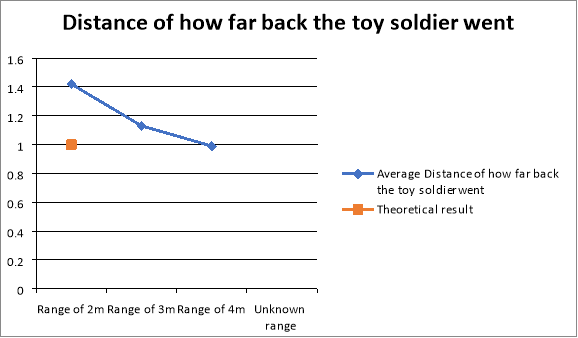
Discussion and Conclusion:
Looking at the results from table one and the graph one, a pattern emerges that shows how the further away the shooter is, the less the toy soldier goes back. Table one shows that although there is a decrease in the length of how far back the toy soldier goes; the results were not all similar to each other in that there wasn’t just a two or five centimetre difference, but a 10-30 cm difference. Graph one shows the average of how far back the toy soldier goes and shows that the further back the shooter is, the less momentum there is to pass onto the object.
In the first five shots, (range of two metres) an anomaly occurred that was not included in graph one. Compared to the other distances, it was not included as it had an 80cm gap between the next smallest distance that was recorded. The reason for why this occurred is unknown but the most logical reason for this anomaly is that the bullet hit the ground just before hitting the toy soldier loosing most of its momentum before impact.
The results from the experiment also are similar to a real world bullet, in that when a bullet is fired, wind, air resistance and gravity affect the travel and trajectory of where it will land. Wind impacts the sideways movement and with air resistance, it slows down the speed of the bullet. Gravity impacts the height and overall distance of the bullet. These three impacts affect the nerf bullet just the same, but a lot more as the bullet its lighter and has less energy behind it.
The results from the experiment shown in table one and graph one show the distance decreases as the shot is taken further back. Compared to the theoretical table, the results between the theoretical and experimental calculations are not similar as there is a significant difference in the distances when compared. The theoretical result is close to the distance of how far back the two people go in the movie The Brothers Grimsby where the experimental results are about a metre off.
The results from the table and chart from the experiment show that increasing distance from where the shooter shoots from will reduce the distance of how far the toy soldier travels backwards. Therefore the hypothesis, “If the momentum of a bullet out of a nerf gun is passed on to a toy soldier, then it will travel backwards because of the Momentum Conservation Principle” is shown to be supported.
Evaluation:
The errors of the experiment consist of the shooter and the environment. The errors of the shooter involve accuracy, data recording and the position of where the gun was held. The environment that the experiment was held in also affected the results in how the bullet was affected by its surroundings (air conditions) and also the room itself.
Accuracy of the bullet hitting the toy soldier had a major effect to how far back the soldier would go backwards. The reason why this was a problem is because if the bullet hits the soldier in the arm, then it won’t go straight back, but more of a diagonally path that is to the left or right of the soldier. The momentum transfer is also affected because the arm is smaller than the bullet, not all of the energy will transfer compared to if it was shot in the chest.
Data recording was done to a good standard, yet improvements can be made to make sure the right length is recorded to improve overall accuracy. As the toy soldier is five centimetres long, choosing what spot (head, feet or the chest) to look at to measure from when next to the tape measure was a problem. The solution to fix this is to have a laser set up with the point of the toy soldier that it furthest away from where it was when shot. This solution would give an increase in accuracy with the way data is recorded.
The position of where the shot was made from also affected the results taken, but also how much momentum the bullet had upon impact. If the gun is in front of the point where it should be on the measuring tape, then the bullet will have more momentum than if it was shot from behind the point on the measuring tape. Although this will have only minor affects, a centimetre or two will decrease the accuracy of the average distance of how far back the toy soldier went.
The overall experiment can be improved to help the accuracy of the results. Although the nerf gun is scaled down in the speed of a real gun, by having real guns and bullets the experiment will be similar to that of the movie scene. The object that would be shot at could be a pig or mannequin (as shown in MythBusters) that is similar in size and weight of a real person and placed on a stand to hold it up right. In the experiment, different bullet sizes can be used to see the differences of a .22 to a 9mm to a 50 calibre.
The hypothesis for the experiment that was conducted can be improved. The new hypothesis that could be tested is, when a nerf bullet is shot at a toy soldier, the distance of how far back it moves will decrease as the range is increased.
Bibliography
In-text: (“Grimsby Brothers,2016”)
Your Bibliography: “Grimsby’s Finest Nobby Opens Up About New Film Detailing His Life”. Newscom Au. N.p., 2017. Web. 4 Mar. 2017.
In-text: (9mm Ammo, 2017)
Your Bibliography: 9mm Ammo. (2017). [online] Available at: http://9ammo.com/ [Accessed 18 Mar. 2017].
TOY MICROWAVE PICTURE
In-text: (Aliexpress.com, 2017)
Your Bibliography: Aliexpress.com. (2017). toy microwave Picture [online] Available at: http://www.aliexpress.com/item-img/1-Soft-Bullet-Clip-And-20-Pcs-Bullets-For-Nerf-Gun-Toy-Cartridge-Dart-Magazine-Ammo/32510200688.html# [Accessed 18 Mar. 2017].
MOMENTUM
In-text: (Physicsclassroom.com, 2017)
Your Bibliography: Physicsclassroom.com. (2017). Momentum. [online] Available at: http://www.physicsclassroom.com/Class/momentum/u4l1a.cfm [Accessed 18 Mar. 2017].
MOMENTUM CONSERVATION PRINCIPLE
In-text: (Physicsclassroom.com, 2017)
Your Bibliography: Physicsclassroom.com. (2017). Momentum Conservation Principle. [online] Available at: http://www.physicsclassroom.com/class/momentum/Lesson-2/Momentum-Conservation-Principle [Accessed 18 Mar. 2017].
NEWTON’S THIRD LAW
In-text: (Physicsclassroom.com, 2017)
Your Bibliography: Physicsclassroom.com. (2017). Newton’s Third Law. [online] Available at: http://www.physicsclassroom.com/class/newtlaws/Lesson-4/Newton-s-Third-Law [Accessed 18 Mar. 2017].
NERF GUN DART SPEED-PART 2 – STOKED ABOUT SCIENCE
In-text: (Stoked About Science, 2017)
Your Bibliography: Stoked About Science. (2017). Nerf Gun Dart Speed-part 2 – Stoked About Science. [online] Available at: http://stokedaboutscience.com/episodes/nerf-guns2/ [Accessed 18 Mar. 2017].
WHAT ARE INDEPENDENT AND DEPENDENT VARIABLES?-NCES KIDS’ ZONE
In-text: (Nces.ed.gov, 2017)
Your Bibliography: Nces.ed.gov. (2017). What are Independent and Dependent Variables?-NCES Kids’ Zone. [online] Available at: https://nces.ed.gov/nceskids/help/user_guide/graph/variables.asp [Accessed 18 Mar. 2017].
Cite This Work
To export a reference to this article please select a referencing stye below:
Related Services
View allDMCA / Removal Request
If you are the original writer of this essay and no longer wish to have your work published on UKEssays.com then please click the following link to email our support team:
Request essay removal



